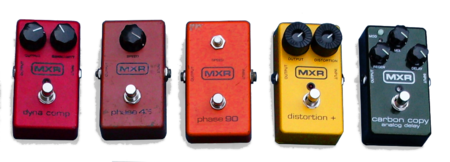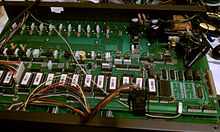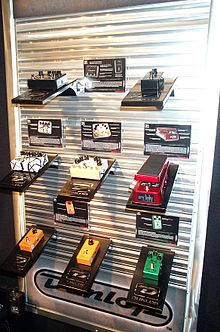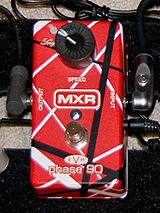- MXR
-
MXR, also known as MXR Innovations, was a manufacturer of guitar effects units, co-founded in 1973 by Keith Barr (who went on to found Alesis) and Terry Sherwood (who went on to co-found Applied Research & Technology).[1] MXR was based in the United States in Rochester, New York. MXR Innovations, Inc. was incorporated in 1974. The MXR trademark is now owned by Jim Dunlop, which continues to produce the original effects units along with new additions to the line.
Contents
History
Founded in 1973, MXR Innovations entered the effects market as a pioneer with the development of tough and rugged stomp boxes, simple utilitarian designs and small sizes. Jim Dunlop, having purchased the brand in 1987, continues MXR’s traditional pedal line of original MXR classics that have come to define the brand, such as the Phase 90 and Dyna Comp, as well as modern pedals like the Carbon Copy and Fullbore Metal. Dunlop has also added a line dedicated to bass effects boxes, MXR Bass Innovations, which has recently released the Bass Octave Deluxe and Bass Envelope Filter. Both pedals won Editor Awards in Bass Player Magazine and Platinum Awards from Guitar World Magazine. The MXR Custom Shop is responsible for recreations of vintage models such as the hand-wired Phase 45, as well as doing limited runs of pedals featuring premium components and highly modified designs such as the new Custom Comp.
Product line
Reference Series (1973–1984)
The first MXR effects pedal was the M-101 MXR Phase 90, widely used on the first two Van Halen albums.[2] The MXR Phase 45, a milder version of the Phase 90, was also released, as well as a programmable version, the Phase 100'’. A 9 volt battery was used to power these effects and could give them up to 500 hours of power. The input was directly connected to the circuit’s power supply (which is very common in vintage effect pedals, such as the Crybaby wah). When the pedal was not in use, players were instructed to remove the cable from the pedal’s input to conserve battery life. When the battery finally did run out, in order to replace it, one had to unscrew the bottom plate, and plug the new battery in, replacing the screws upon completion. Each of the pedal’s enclosures had 4 screws attaching the bottom plate. Like many other pedals of the day, MXR pedals (prior to 1981) did not have LEDs, A/C adaptor jacks, or true-bypass switching. Over the years, there were two distinct periods that the reference series pedals went through. Each of these two periods, however, had two sub phases which will be explained below.
First, was the "Script Period." This is in reference to the cursive writing found on the pedal’s casing. The earliest MXR script pedals were housed in BUD boxes. These “BUD” boxes were cast out of aluminum, by the Bud Box Company located in Willoughby, Ohio. Later, MXR still made script logo pedals, but they were housed in zinc die cast casings made in-house. When compared side by side, the aluminum “BUD” boxes are considerably lighter in weight than the zinc boxes. The earliest script logo pedals were actually made in the basement shop of the founders of MXR[3] and the logos were silk screened by hand. These very first pedals can be identified by a slightly larger font “MXR" on the case. These script pedals had carbon film resistors and are regarded by vintage gear collectors as the best of the best. The full line of MXR pedals to bear the script logo are as follows: Phase 45, Phase 90, Phase 100, Dyna Comp, Noise Gate / Line Driver, Distortion + and Blue Box. These pedals routinely go for $200 to $300 US depending on which pedal it is it is and in what condition it is in. The Blue Box, Phase 90 and Dyna Comp are the three most valuable and collectible MXR “script” pedals. The Dyna Comp from the “script” era had a CA3080 metal can IC in the circuit and to tone buffs and vintage gear connoisseurs this circuit is the cream of the crop. As the script-logo era was coming to a close and the box-logo era was beginning, there was a bit of a transitional period.
The "Box Logo Period 1" was next. This began to happen around 1975-6 and lasted until 1981. The main way to tell a script logo versus a box logo is the most obvious one, the writing on the front of the box. Also, the usage of carbon film resistors on the interior circuits. These resistors look cylindrical in appearance and have old school tape lines on them which are color coded to tell you the value of the piece. Around the time the company logo changed, the resistors and other parts such as capacitors and diodes changed as well. Metal film resistors are easy to spot because they resemble the bodies of ants and are not perfectly cylindrical in shape. They are less noisy and are smaller than carbon film resistors. During this transitional period, some script logo pedals had box logo circuits, and vice versa. This is why it is important to check the circuits of every vintage MXR pedal you are thinking about buying. Sometimes what you're buying isn’t what you think it is, which can be good or bad. The list of pedals included in the box logo era are the same as above with the addition of the micro flanger, micro chorus, loop selector, envelope filter, 6-band equalizer, 10-band equalizer and micro amp. The pedals in the first period did not have LEDs, A/C adaptor jacks, or true-bypass. The “Box logo period 2" changed that though. These box logo pedals are very collectible too; many collectors seek out these pedals as they are cheaper than the script logo pedals, and if they get lucky, they may even end up with a script logo circuit in the end. The second phase of the box logo pedals started to take place in early 1981, and went until 1984, when the company shut its doors (or stopped making pedals). The main change in this era was the addition of LEDs and A/C adaptor jacks. These pedals used 1/8" power jacks and had exactly the same circuit board as their pre-1981 box logo brothers.
- M-101 MXR Phase 90
- M-102 MXR Dyna Comp (compressor)
- M-103 MXR Blue Box (distortion and octaving effect)
- M-104 MXR Distortion +
- M-105 MXR Phase 45
- M-106 MXR Noise Gate & Line Driver
- M-107 MXR Phase 100 (slightly larger case)
- M-109 MXR 6-Band Graphic Equalizer
- M-120 MXR Envelope Filter
- M-133 MXR Micro Amp (Un-distorted version of the Distortion +)
- M-148 MXR Micro Chorus
- M-152 MXR Micro Flanger
- M-1?? MXR Western N.A.M.M. Winter 1982
MXR also created several pedals that were AC-powered and were 4¾″ wide by 3½″ tall (some were of different dimensions though):
- M-108 MXR 10-Band Graphic Equalizer
- M-117 MXR Flanger
- M-118 MXR Analog Delay
- M-134 MXR Stereo Chorus
- M-142 MXR Distortion II
- M-143 MXR Limiter
Accessories
- M-121 MXR Foot Switch
- M-137 MXR Power Converter (include one pack)
- M-138 MXR Back Plate Adapter (6 per pack)
- M-144 MXR Loop Selector
- M-157 MXR Headphone Amplifier
Commande Series (1981–1984)
In 1981, MXR introduced a line of inexpensive plastic ("Lexan" polycarbonate) pedals known as the Commande Series. These were priced to compete with the Japanese-manufactured effects pedals that were flooding the US and world markets. These were a departure from the Reference Series in several aspects. The input, output and power jacks were all moved to the top of the case to allow a tighter grouping on the floor, or pedal board. Also, for the first time, MXR incorporated a large footswitch.
- M-161 MXR Phaser
- M-162 MXR Preamp
- M-163 MXR Sustain
- M-164 MXR Overdrive
- M-166 MXR Time Delay
- M-167 MXR Stereo Chorus
- M-168 MXR Stereo Flanger
2000 Series (1982–1984)
The Series 2000 was a complete rework of the Reference and Commande lines of pedals. These were higher quality pedals, with electronic FET switching and dual LED indicators. They had a new contoured shape, an all-metal chassis and an easily removable plastic battery compartment door. These were fully rubberized on the bottom surface and were remote-controllable. The complete series 2000 line is very user friendly and the sounds they produce are very musical. Most of the pedals had two outputs that provide two distinctly different versions of the same pedal.
The MXR Series 2000 sported six models. These original pedals in the series included the Dyna Comp, Distortion +, Phaser, Stereo Chorus, Stereo Flanger and Time Delay. In late 1983 MXR announced a digital sound effects pedal generator simply known as the ‘’Junior’’. The Junior was released in early 1984 and was added to the other six pedals in the Series 2000 line. The Junior boasted four sound effects: a laser, a clap, a snare and a high hat. These sound effects or samples were written on a large 24-pin ROM chip that was produced by MXR. The ROM chip had to be inserted into the circuit in order for the sounds to register. Two of these ROM chips were produced—the MXR-211a and the MXR-211b. The 211a was installed at the factory and the 211b was sold separately in little plastic containers (like the chips for the MXR drum computer). The 211b is very rare and little is known about it or what sounds it produced. The reason for this is the simple fact that the Junior was only sold for about year or so and the chip (211b) that wasn’t inside the unit, was either lost or discarded. The Junior is not what you would call a normal guitar effect pedal. It didn’t work like a phaser or flanger; it did not produce any effect that enhanced or colored your guitar’s original tone. The sounds were stand alone. These sounds could be accessed by either pushing the foot switch with your hand or foot, or you could plug an instrument into it and by hitting or picking a note, it would produce the sound. Instead of hearing a regular note, it would be the simulated pre-recorded sound in a drone key that would not correspond to the actual key that you were playing in. The Junior was also made to be used with a trigger device and a drum head that MXR sold as well. The Junior had a selector for each of the four settings, as well as a rate knob that would control the beats per minute.
MXR continued to manufacture most of the Reference, Commande and 2000 Series pedals until they closed their doors in 1984.
- M-200 MXR Master Pedal Series
- M-201 MXR Phaser
- M-202 MXR Dyna Comp
- M-203 MXR Stereo Flanger
- M-204 MXR Distortion +
- M-205 MXR Stereo Chorus
- M-206 MXR Time Delay
- M-210 MXR Junior
- M-211a MXR Sound Effects Chip
- M-211b MXR Sound Effects Chip
MXR rackmount effects
MXR also had a line of professional rackmount effects used by the likes of David Gilmour,[4] Stuart Adamson and Mike Rutherford. These included:
- M-110 MXR Auto Phaser (Mini-vertical rackmount)
- M-111 MXR Auto Flanger (Mini-vertical rackmount)
- M-112 MXR Mini Limiter (Mini-vertical rackmount)
- M-113 MXR Digital Delay Came with 320ms(2U rackmount)
- M-113m MXR 320ms Expansion Up to 4 cards for up to 1280 ms (1.28 Seconds)
- M-115 MXR EQ Parametric Equalizer (Mini-vertical rackmount) (Prototypes Only)
- M-116 MXR Professional Products Rack (Rack, Audio Linking and power for M-110 & M-111)
- M-124 MXR Dual 15-Band Graphic Equalizer (2U rackmount)
- M-125 MXR 31-Band Graphic Equalizer (2U rackmount)
- M-126 MXR Flanger Doubler (2U rackmount)
- M-129 MXR Pitch Transposer (2U rackmount)
- M-131 MXR Pitch Transposer Display (1U rackmount)
- M-136 MXR Dual Limiter (1U rackmount)
- M-151 MXR Delay System II (2U rackmount) (1.6 Seconds of Delay. Upgradable to (3.2) with the M-155 ad-in)
- M-151-1 MXR Delay System II (2U rackmount) (With 3.2 Seconds Max Delay. Came with the M-155 ad-in installed)
- M-170 MXR Dual Octave Graphic Equalizer (2U rackmount) (Dual 10-Band)
- M-171 MXR Dual 2/3 Octave Graphic Equalizer (2U rackmount) (Dual 15-Band)
- M-172 MXR 1/3 Octave Graphic Equalizer (2U rackmount) (31-Band)
- M-174 MXR Pitchshift Doubler (1U rackmount)
- M-175 MXR Digital Time Delay (1U rackmount) (320ms Max Delay)
- M-180 MXR Omni Multi-Effects Unit (2U rackmount) (See Below)
- M-181 MXR Omni Foot Pedal Switch Board (Floor Unit) (See Below)
- M-186 MXR Digital Time Delay (1U rackmount) (1000ms Max Delay) (Same in appearance as M-175)
- M-190 MXR 1500 Digital Delay (1U rackmount) (1500ms Max Delay)
- M-191 MXR Digital Reverb (1U rackmount)
In 1983, MXR introduced one of the first multi-effect rack units for guitar and bass, the Omni. The Omni had 6 different effects: sustain, distortion, delay, equalization, flanger and chorus. The main unit was a 2U with separate controls for each effect. There was a footpedal (M-181) that enabled the player to switch the different effects on and off, as well as changing the order of the distortion and equalizer effects, a master bypass as well as an effects loop.
MXR Desktop Effects
MXR featured a line of processors that were targeted for home entertainment systems of the day. Most of these items came with wooden (Walnut) side panels. However the larger 17” wide units also had kits available for single or 1U (M-145 Single 1.75” Rack mount kit) and 2U (M-146 Double 3.5” Rack mount kits) available. You would unscrew the wooden sides and install the rack pieces and you would now have a fully 19” rack-mountable device.
- M-114 MXR Stereo 10-Band EQ (Desktop only unit)
- M-119 MXR Compander Noise Reduction - Increases dynamic range of tapes. (Desktop only unit)
- M-123 MXR Dynamic Processor Expander (2U (Rack-mountable with M-146))
- M-127 MXR Stereo 15-Band EQ (2U (Rack-mountable with M-146))
- M-128 MXR Mono 31-Band (2U (Rack-mountable with M-146))
- M-132 MXR Dynamic Expander Feature rich Expander (2U (Rack-mountable with M-146))
- M-139 MXR Linear Preamp Stereo switching and routing prior to amplification. (1U (Rack-mountable with M-145))
- M-140 MXR System Preamp Has a single AUX Input (2U (Rack-mountable with M-146))
- M-147 MXR Stereo Octave EQ (2U (Rack-mountable with M-146))
- M-150 MXR System Preamp II Has a (2) RIAA Phono Inputs (2U (Rack-mountable with M-146))
- M-153 MXR 5-Band Stereo EQ (Desktop only unit)
- M-156 MXR Discorder CX Process Decoding of Records. (Desktop only unit)
Drum Computers
In late 1981, MXR got the resale rights in the US to sell the KIT (M-178), a digital drum machine. In early 1983, MXR released the M-185 [1] MXR Drum Computer, followed by the Drum Machine II (M-189). These were all similar to Roger Linn's Linn LM-1 drum machine.
Jim Dunlop and MXR
Jim Dunlop (the company famous for the Cry Baby Wah-Wah) bought the MXR licensing rights and currently manufactures reissues of some of the classic MXR effects pedals. Dunlop has created new models in addition to the original lineup, including signature pedals such as Eddie Van Halen Phase 90 and Flanger, and Zakk Wylde's Wylde Overdrive and Black Label Chorus.[5]
New MXR Reference Series
- M-66 MXR Classic Overdrive
- M-78 MXR Custom Badass Distortion
- M-80 MXR Bass DI
- M-82 MXR Bass Envelope Filter
- M-86 MXR Classic Distortion
- M-87 MXR Bass Compressor
- M-101 MXR Phase 90
- M-102 MXR Dyna Comp
- M-103 MXR Blue Box
- M-104 MXR Distortion +
- M-107 MXR Phase 100
- M-108 MXR 10-Band EQ (2 fader added, Volume and Gain)
- M-109 MXR 6-Band EQ
- M-115 MXR Distortion III
- M-116 MXR Full Bore Metal
- M-117R MXR Flanger (Reissue)
- M-120 MXR Auto Q
- M-132 MXR Super Comp
- M-133 MXR Micro Amp
- M-134 MXR Stereo Chorus (2 knobs added, Bass and Treble)
- M-135 MXR Smart Gate
- M-148 MXR Micro Chorus (Reissue 2010)
- M-151 MXR Double Shot Distortion
- M-152 MXR Micro Flanger (Reissue 2010)
- M-159 MXR Stereo Tremolo
- M-169 MXR Carbon Copy Analog Delay
- M-173 MXR Classic 108 Fuzz
- M-181 MXR Bass Blowtorch (Overdrive)
- M-182 MXR El Grande Bass Fuzz
- M-188 MXR Bass Auto Q
- M-195 MXR Noise Clamp
- M-288 MXR Bass Octave Deluxe
- M-234 MXR Analog Chorus
MXR Custom Audio Electronic (CAE)
- MC-401 MXR Boost / Linedrive
- MC-402 MXR Boost / Overdrive
- MC-404 MXR Wah
- MC-403 MXR Power System
MXR Custom Shop (CSP)
- CSP-001 MXR Variphase
- CSP-026 MXR 74 Vintage Phase 90
- CSP-028 MXR 76 Vintage Dyna Comp
- CSP-101SL MXR Phase 90
- CSP-105 MXR 75 Vintage Phase 45
- CSP-202 MXR Custom Comp
MXR Signature Series
Dimebag Darrell Series
- DD11 MXR Dime Distortion
Eddie Van Halen Series
- EVH90 MXR Phase 90
- EVH117 MXR Flanger
Kerry King Series
- KFK1 MXR Kerry King 10-Band EQ
Zakk Wylde Series
- ZW38 MXR Black Label Chorus
- ZW44 MXR Wylde Overdrive
- ZW90 MXR Wylde Phase
References
- ^ "In Memoriam: Keith Barr 1949-2010", Mix Magazine Online, Aug 25, 2010 http://www.mixonline.com/news/keith_barr_obit_2508/
- ^ "Eddie Van Halen's Rig and Tone Techniques". http://www.amptone.com/eddievanhalenrig.htm.
- ^ Rob Hughes, "Selectron to Distribute Rochester Series Pedals", MI Pro, Oct 2009 http://www.mi-pro.co.uk/news/30577/Selectron-to-distribute-Rochester-pedals
- ^ Tolinski, Brad (September 1994). "Welcome to the Machines". Guitar World. http://www.pinkfloydfan.net/t11634-phil-taylor-welcome-machines-guitar.html. Retrieved 2011-07-29.
- ^ "Current MXR Pedals Catalog". http://www.jimdunlop.com/index.php?page=products/p_and_e_detail&cat=16.
External links
Categories:- Music equipment manufacturers
- Effects units
- Guitar effects manufacturing companies
- Companies established in 1972
Wikimedia Foundation. 2010.






